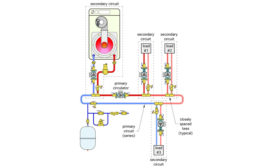Home » hydronics
Articles Tagged with ''hydronics ''
Creating a Hands-on Hydronics Lab
Donated equipment offers students a high-tech experience
Read More
A Look Inside One Hydronic/HVAC Pro’s Tool Bag — Part 2
Choosing the right hardware for your work
Read More
Danfoss Adds New Regional Sales Manager
Scott Cohen will support the hydronic heating business
March 21, 2017
Weil-McLain Launches 2017 ‘School of Better Heating’
Personalized training programs for HVAC professionals
March 15, 2017
Hydronics Equipment Growing More Efficient, Intelligent
Many companies showcased their solutions at the 2017 AHR Expo
Read More
Renovation Renews Retirement Home for Pennsylvania Family
Home remodeling project revolved around mechanical systems
December 26, 2016
Copyright ©2024. All Rights Reserved BNP Media.
Design, CMS, Hosting & Web Development :: ePublishing











